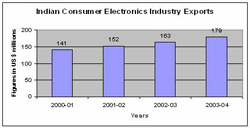| Size of the INDUSTRY | Indian electronics industry today stands at US $ 25 billion |
| Geographical distribution | All the major Metropolitans cities in the India |
| Output per annum | It is growing at over 25% CAGR and is expected to be worth US $ 158 billion by 2015 |

The domestic Electronic industry also responded favorably to the policies of the government. The initiatives of the electronics field to private sector enabled entrepreneurs to establish the industries to meet demand in the market. Improvements in the Indian Electronics industry have not been limited to a particular segment, but encompass all its sectors. This pace made in the areas of commercial software, telecommunications, electronics, instrumentation, positioning and networking systems, and defense. The result therefore has been a significant trade growth that began in the late 1990's. The Indian Electronics Industry is a text for investors who consider India as a potential investment opportunity.

Despite the global economic slowdown, growth of Indian electronics industry in 2009 was on par with the previous year at 9.9%, although this was decreased according to the double-digit growth achieved in 2006 and 2007. In 2010 output grown by 13.6% and in the medium to long-term India will continue to show strong growth driven by a large, fast growing domestic market, significant foreign investment and an improving regulatory environment. The global electrical and electronics industry has various adjunct sectors. Few of them are Electronic Components, Computer & Telecommunications, Office Equipments, Consumer Electronics as well as Industrial Electronics.
Indian electronics industry today stands at US $ 25 billion and is ranked 26th in the world in terms of sales and 29th in the world in terms of production. It is growing at over 25% CAGR and is expected to be worth US $ 158 billion by 2015. Electronic industry is one of the fastest growing industries in the country and is driven by growth in key sectors such as IT, Consumer Electronics and Telecom.
|  |
The demand for electronics is expected to be fuelled by the growth of
- Telecommunications (250 million subscribers by the next few years)
- PCs and Notebooks (5 million every year)
- Broad-Band connectivity reaching rural areas
Video Projectors: Phil Systems, Keltron Projectors, Birla 3M, Samrat Video Vision
Colour Television: LG Electronics, Philips, Sony; Sansui, Samsung, BPL, Videocon, Onida, Aiwa, Akai, Thompson, Panasonic.
Cameras/Camcorders: Sony, Canon, Olympus, Fuji film, Nikon
- The Indian Electronic industry constitutes less than 1% of the global market. However, demand for these products are growing rapidly and investments are flowing in to augment manufacturing capacity.
- Today India remains a major importer of electronic materials, components and finished equipment amounting worth of $20 billion (Rs84, 000 crore ) in 2007. The country imports electronic goods mainly from China
- In past four years, production of computers has grown at a compounded annual growth rate (CAGR) of 31%, which is highest among the various electronic products in India. And then the production is followed by communication and broadcast equipment (25%), strategic electronics (20%) and industrial electronics (17%).
- The consumer electronics segment has grown at a CAGR of 10% in the last five years includes a wide range of products such as DVD, VCD/MP3 players, television sets and microwave ovens.
- The growth in demand for telecom products has been high, with India adding two million mobile phone users every month, which serves as one of the main reasons for the growth in production of electronic goods. This growth is expected to continue over the next decade, too.
- To attract foreign investment the government has adopted Chinese style Special Economic Zones with the aim to provide islands of excellence where the infrastructure is world standard. Fifteen-year tax breaks given to foreign investors and SEZs are treated as foreign territories for the purpose of trade operations, duties and tariffs.
- India has been a great success story in the IT services industry and the next great opportunity is to create our own electronics product industry, which will help to move up the value chain and create global technology brands. Today the market is at the threshold of a decisive phase in our growth where, if the government and entrepreneurs take concrete steps it can create a $100 billion electronics product industry from India in the next 10 years.
- Multi national corporations provide growing electronics market to India at lower costs by manufacturing semiconductors in India. India has the potential to come up as the next electronics and hardware destination in the world. The chip design and other complex components electronic device can be acquired from the Indian companies at low cost.
- India is growing up to be one of the biggest markets for electronic instrumentations. The consumption value of electronic equipment in India in 2005 is estimated as US$ 28.2 billion. The main factor pertaining to the success of the Indian Electronics and Hardware Industry is the growth in the market demand. The growth in the manufacturing of semiconductor serves as the key driver in the emergence of India as one of the leaders. The advantages pertaining to the taxes and duties, the access to technical and engineering expertise, proper manufacturing facilities, lucrative investment offers, etc.
 Recent Press Release
Recent Press Release
 INDIAN electronics INDUSTRY AT A Glance IN 2021 - 2022
INDIAN electronics INDUSTRY AT A Glance IN 2021 - 2022
 INDIAN electronics INDUSTRY AT A Glance IN 2020 - 2021
INDIAN electronics INDUSTRY AT A Glance IN 2020 - 2021
 INDIAN electronics INDUSTRY AT A Glance IN 2019 - 2020
INDIAN electronics INDUSTRY AT A Glance IN 2019 - 2020
 INDIAN electronics INDUSTRY AT A Glance IN 2018 - 2019
INDIAN electronics INDUSTRY AT A Glance IN 2018 - 2019
 INDIAN electronics INDUSTRY AT A Glance IN 2017 - 2018
INDIAN electronics INDUSTRY AT A Glance IN 2017 - 2018
 INDIAN electronics INDUSTRY AT A Glance IN 2016 - 2017
INDIAN electronics INDUSTRY AT A Glance IN 2016 - 2017
 INDIAN electronics INDUSTRY AT A Glance IN 2015 - 2016
INDIAN electronics INDUSTRY AT A Glance IN 2015 - 2016
 INDIAN electronics INDUSTRY AT A Glance IN 2014 - 2015
INDIAN electronics INDUSTRY AT A Glance IN 2014 - 2015
 INDIAN electronics INDUSTRY AT A Glance IN 2013 - 2014
INDIAN electronics INDUSTRY AT A Glance IN 2013 - 2014
 INDIAN electronics INDUSTRY AT A Glance IN 2012 - 2013
INDIAN electronics INDUSTRY AT A Glance IN 2012 - 2013
 INDIAN electronics INDUSTRY AT A Glance IN 2011 - 2012
INDIAN electronics INDUSTRY AT A Glance IN 2011 - 2012
 Elcina electronic industries association of India
Elcina electronic industries association of India
 Indian Electrical & Electronics Manufacturers Association(IEEMA)
Indian Electrical & Electronics Manufacturers Association(IEEMA)
 Winding Wires Manufacturers Association (WWMAI)
Winding Wires Manufacturers Association (WWMAI)
Indian Industries
 |
INDIAN INDUSTRIES |



 INDIAN ELECTRONIC INDUSTRY
INDIAN ELECTRONIC INDUSTRY